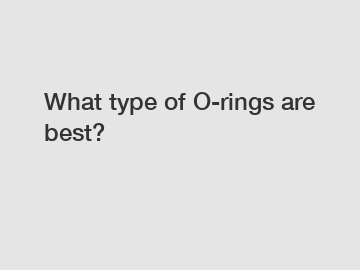What type of O-rings are best?
What type of O-rings are best? This is a common question among engineers and manufacturers who rely on O-rings for their sealing applications. The answer, however, is not as straightforward as one might think. It depends on various factors such as the application requirements, operating conditions, and material compatibility. In this article, we will explore the different types of O-rings, their characteristics, and the considerations to make when selecting the best type for your needs.
H2: Types of O-rings.
There are several types of O-rings available on the market, each designed to meet specific application requirements. The most common types include Nitrile (Buna-N), Viton (fluorocarbon), EPDM (ethylene propylene diene monomer), Silicone, and PTFE (polytetrafluoroethylene). .

H3: Nitrile (Buna-N).
Nitrile O-rings are known for their excellent resistance to oil, fuel, and other non-polar fluids. They have a wide temperature range (-40°C to +120°C) and are cost-effective. These O-rings are commonly used in automotive, oil and gas, and aerospace industries.
H3: Viton (Fluorocarbon).
Viton O-rings are highly resistant to extreme temperatures, chemicals, and gases. They can withstand temperatures ranging from -20°C to +200°C and provide excellent sealing performance in aggressive environments. They are widely used in chemical processing, semiconductor, and oil refining industries.
H3: EPDM.
EPDM O-rings offer outstanding resistance to heat, ozone, and weathering. They can handle temperatures from -50°C to +150°C and provide excellent electrical insulation properties. EPDM O-rings are commonly used in HVAC systems, water treatment plants, and outdoor applications.
H3: Silicone.
Silicone O-rings exhibit excellent flexibility and high-temperature resistance. They can withstand temperatures from -60°C to +230°C and have low chemical reactivity. Silicone O-rings are commonly used in medical devices, food processing equipment, and high-temperature applications.
H3: PTFE (Polytetrafluoroethylene).
PTFE O-rings have outstanding chemical resistance and low friction properties. They can handle temperatures from -200°C to +260°C and are suitable for sealing aggressive media. PTFE O-rings are commonly used in chemical processing, pharmaceutical, and food industries.
The type of O-ring that is best for your application depends on several factors. Considerations include the operating temperature, chemical compatibility, pressure, and desired lifespan. It is important to consult with O-ring manufacturers or experts to ensure you select the most suitable type for your specific needs.
In conclusion, there is no one-size-fits-all answer to the question of what type of O-rings are best. It depends on the specific application requirements and operating conditions. By considering factors such as temperature range, chemical resistance, and material compatibility, you can select the best type of O-ring for optimal sealing performance and long-lasting reliability.
If you want to learn more, please visit our website custom o rings, tc rubber seal, tc nbr oil seals.


